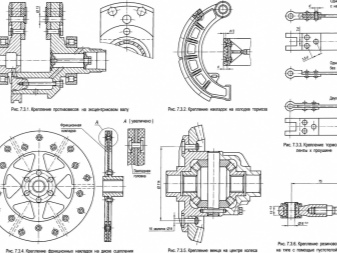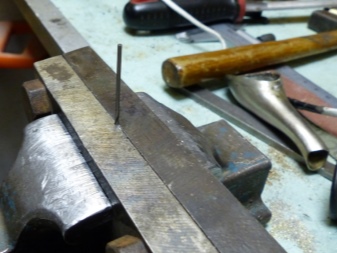How to make rivets with your own hands?

In a city apartment, you can find not so many products made with rivets. But in a rural house or garage for a craftsman, these fasteners can always come in handy. But in the absence of them, you should not despair, since it is not difficult to make a rivet with your own hands. Moreover, it will be no worse than the factory one in terms of reliability and service life.


Tools and materials
If a person needed a large amount of such fasteners, then it is more profitable to independently make it from aluminum or copper wire. Rivets are also made of brass wire, but it is rarely at hand.
For a large volume of fasteners, it is better to make a special device, which, with a stretch, can be called a rivet machine. The tool is a thick steel bar in which holes of different diameters and depths are drilled (according to the dimensions of the required fasteners). If a suitable metal bar of the required thickness is not available, then it can be made type-setting - to fasten together several plates of steel blanks with a smaller thickness (2-5 mm).


The plates must have the same length and width dimensions. You can fasten them with welding or bolts.
If you need several rivets, then no device should be made. - it will be enough to have a hammer, a vice, a flat file and a chisel to chop the required number of wire blanks. Sometimes you may need an electric drill with a set of drills of different sizes and a center punch.
The wire is taken with such a cross-section to reliably carry the function of fasteners as rivets. Most often, a cross section from 6 to 20 mm is used, but this parameter depends on the size of the structure that will need to be riveted. For rivets, the conductors of an electric cable are best suited.
A good option is homemade rivets of thinner diameters, made from construction nails.

Manufacturing
The preparation of blanks should be started after finding out the true dimensions necessary for a high-quality result of subsequent riveting work. You should know exactly the thickness of the connection of the parts that need to be riveted in order to calculate the correct length of the workpiece, taking into account its processing under the mortgage head and lock.
If the connection is complex, and different lengths of riveting material are required, then it is better to make a drawing on which you mark all the places indicating the thickness of the connection in the finished form, and already from this proceed in calculations about the length of the blanks.


According to the diagram, it will be clear how many blanks are required for each length. Then, using a chisel and a hammer, cut the workpieces from the wire with a margin of quantity.

Making rivets consists of a number of operations. First - about how to make a rivet from a wire with a machine.
- We select on the machine a hole that is suitable in diameter and length for the workpiece we need. The workpiece must have a sufficient length of the protruding part, from which the insert head is to be formed.
- By tapping with a hammer on the protruding part of the wire, we form a head. First, flatten the end of the wire with blows from above so that a head is formed, like a nail, and then we process this head by tapping on the sides, giving it a spherical look.
- After the formation of the head, we will correct the result with a file, if it matters for the appearance of the structure to be joined.
- We remove the workpiece from the hole and process the end opposite to the head (align with a file or sharpener).


When making a rivet without a machine, exactly the same actions are performed as with it, only the workpiece is clamped in any other device, for example, in a vice. All other operations are performed in the same order as on the machine.
Sometimes it is necessary to make rivets with flat or countersunk heads. In the latter case, you can also use the device mentioned above.


To do this, you need to drill as many holes in the bar as required - they are made deeper than the length of the blind rivets. These holes should then be widened from above under the cone with a drill with a diameter slightly larger than the holes themselves (under the head).
It is in these newly prepared holes that workpieces are inserted, the length of which is matched to the depth of the hole plus a small protrusion on the head. It remains only to knock on the end of the wire with a hammer, filling the prepared bed for the head with flattening so that it does not protrude above the surface of the machine.

Rivets with flat heads can be made using the same technology as the previous version, but only the bed for the formation of this part of the product is drilled cylindrical, not conical.
It is convenient to make a homemade rivet of a small diameter, consisting of two parts - a mortgage and a lock - from a pair of nails. To do this, one of the nails is taken with a larger diameter - a hole is drilled in its rod that is 0.1 mm less than the diameter of the second nail.

It will function as a future rivet lock.
The second nail, the rod of which should have a shorter length than the depth of the lock hole, is sharpened at the end under the cone. The nail heads are ready-made heads, only you will need to grind a little for the look. The hole in the joint for which such a rivet was prepared is drilled to the size of the diameter of the locking part of the fastener.

Recommendations
For a better and more efficient manufacture of homemade rivets, you need to heed some recommendations.
- Spherical heads of finished products are always easy to transform into heads of the desired shape by grinding or mechanical action.
- Before drilling a hole in the shaft of the locking part of the rivet, it is necessary to mark the center with a core for accurate installation of the drill.
- To grind the heads and ends of products, you can use a drill by inserting the workpieces into the tool holder, and when rotating, resting them against the grinder.
- If a large amount of work is planned for the manufacture of rivets, the best solution would be to make a device for this and even buy a ready-made machine. Otherwise, the work will take a long time.


How to make rivets with your own hands, see below.













The comment was sent successfully.